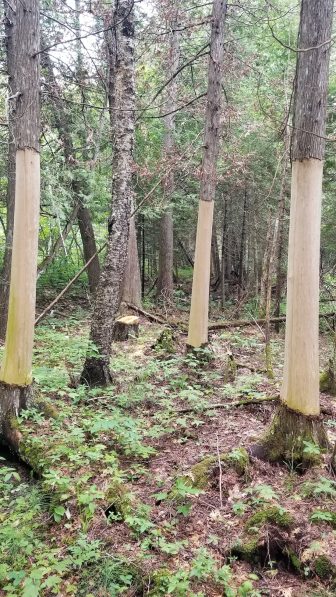
Groves of bark-stripped cedars have been discovered in the St. Ignace district of Michigan’s Hiawatha National Forest. Those responsible could be charged with a felony and spend up to a year in prison, according to state law. Image: Robin Clark
By Daniel Schoenherr
Less than two miles past the Mackinac Bridge in Michigan’s Upper Peninsula are dozens of cedars stripped of their bark and left to die.
“It is probably the most obscene thing I’ve witnessed,” said Renee Dillard, an elder of the Little Traverse Bay Bands of Odawa Indians who recently discovered the damaged trees. To Dillard and the tribe, the desecration represents the continued exploitation of their land and its people.
Although sustainable bark harvest is now coded into local tribal law, Dillard said, it is only a “baby step” toward preventing further damage to the area’s cedars.
Cedars, known by tribe members as giizhik, are a significant part of Anishinaabe culture, Dillard said. Giizhik is one of the tribe’s four sacred medicines, and is often considered women’s medicine because women traditionally collect its bark and leaves. Giizhik leaves have anti-inflammatory properties that help reduce joint pain and fevers, according to a study published by the U.S. National Institutes of Health.
Dillard is a weaver and tribal educator who uses cedar bark to create traditional sleeping mats. Making a giizhik mat in a safe and respectful manner takes about a year of work and attention, she said.
“I can go and visit these old cedars and I only take a portion of their bark,” she said. “It will hurt them and it will scar them, but it won’t kill them.”
A small strip of bark — about the size of a five-foot two-by-four — can be harvested from a large cedar without leaving it susceptible to disease. But in January, Dillard was devastated to discover groves of trees in Hiawatha National Forest that had the bottom 10 feet of bark completely stripped — or girdled — around the trunk.
The girdled trees reminded her of the Missing and Murdered Indigenous Women movement which was started to raise awareness for the high murder and disappearance rates among the indigenous community. To Dillard, the trees looked like the red dresses her community hangs to represent their tragic losses.
“Cedar is women’s medicine and it’s our responsibility,” she said. “When I went into those woods, all I saw were red dresses hanging.”
Tribe members are using the rest of the girdled cedars to make canoe ribs and rice harvesting tools, but the forest itself will take a long time to recover, Dillard said.
Many tribe members believe a non-member stripped the bark, she said, likely to make and sell weaved goods.
“I can’t imagine how they would think that that would be okay in any culture,” she said. “People that exploit our culture and our ways own it. There’s no reciprocal relationship with those things, and that’s painful.”
Dillard and other tribe members are seeking protections and justice from law enforcement officials, but no action has been taken yet. Hiawatha National Forest’s St. Ignace/Sault Ste. Marie Ranger District office has not responded to repeated requests for comment.
To prevent further damage to trees on their land, tribal leaders documented sustainable cedar harvest practices in the Sault Ste. Marie Tribe of Chippewa Indians tribal code. This will ensure cultural and environmental protections, said Robin Clark, the natural resources director of the Sault Ste. Marie Tribe of Chippewa Indians.

Harvesting one hand-width strip of bark from an old-growth cedar will not kill it, said Robin Clark, the natural resources director of the Sault Ste. Marie Tribe of Chippewa Indians. Image: Robin Clark.
“We’re hoping that folks who want to go out and abuse giizhik forests or trees…will see that there are loud and clear regulations prohibiting those activities,” she said.
There are no additional punishments beyond current laws against damaging national forest trees, Clark said, but tribal law enforcement is monitoring forest activity to prevent it.
Cedar trees are a key component to many Michigan wetlands called cedar swamps, Clark said. Cedar swamps store groundwater, preventing floods from heavy rain.
“Cedar swamps are a valuable part of our landscape,” Clark said, “especially in light of climate-driven changes.”
And Clark said she hopes the updated tribal code will serve as an example for other natural resource managers across the Great Lakes region.
“Broader awareness and appreciation of giizhik trees and forests is one thing we work to make sure of,” she said.
Dillard agrees:
“I would think people, just the general population at large, would be offended by (killing trees). I can’t imagine how they would think that that would be okay in any culture.”
Editor’s note: This story was updated March 28 to correct photo credits, Robin Clark’s title and the name of a Native American group.
I own land with many beautiful cedar trees. I have watched these majestic trees for over 30 years. They are true survivors and I wouldn’t dream of harming them in anyway or for any reason.